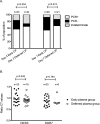Early versus deferred anti-SARS-CoV-2 convalescent plasma in patients admitted for COVID-19: A randomized phase II clinical trial
- PMID: 33657114
- PMCID: PMC7929568
- DOI: 10.1371/journal.pmed.1003415
Early versus deferred anti-SARS-CoV-2 convalescent plasma in patients admitted for COVID-19: A randomized phase II clinical trial
Abstract
Background: Convalescent plasma (CP), despite limited evidence on its efficacy, is being widely used as a compassionate therapy for hospitalized patients with COVID-19. We aimed to evaluate the efficacy and safety of early CP therapy in COVID-19 progression.
Methods and findings: The study was an open-label, single-center randomized clinical trial performed in an academic medical center in Santiago, Chile, from May 10, 2020, to July 18, 2020, with final follow-up until August 17, 2020. The trial included patients hospitalized within the first 7 days of COVID-19 symptom onset, presenting risk factors for illness progression and not on mechanical ventilation. The intervention consisted of immediate CP (early plasma group) versus no CP unless developing prespecified criteria of deterioration (deferred plasma group). Additional standard treatment was allowed in both arms. The primary outcome was a composite of mechanical ventilation, hospitalization for >14 days, or death. The key secondary outcomes included time to respiratory failure, days of mechanical ventilation, hospital length of stay, mortality at 30 days, and SARS-CoV-2 real-time PCR clearance rate. Of 58 randomized patients (mean age, 65.8 years; 50% male), 57 (98.3%) completed the trial. A total of 13 (43.3%) participants from the deferred group received plasma based on clinical aggravation. We failed to find benefit in the primary outcome (32.1% versus 33.3%, odds ratio [OR] 0.95, 95% CI 0.32-2.84, p > 0.999) in the early versus deferred CP group. The in-hospital mortality rate was 17.9% versus 6.7% (OR 3.04, 95% CI 0.54-17.17 p = 0.246), mechanical ventilation 17.9% versus 6.7% (OR 3.04, 95% CI 0.54-17.17, p = 0.246), and prolonged hospitalization 21.4% versus 30.0% (OR 0.64, 95% CI, 0.19-2.10, p = 0.554) in the early versus deferred CP group, respectively. The viral clearance rate on day 3 (26% versus 8%, p = 0.204) and day 7 (38% versus 19%, p = 0.374) did not differ between groups. Two patients experienced serious adverse events within 6 hours after plasma transfusion. The main limitation of this study is the lack of statistical power to detect a smaller but clinically relevant therapeutic effect of CP, as well as not having confirmed neutralizing antibodies in donor before plasma infusion.
Conclusions: In the present study, we failed to find evidence of benefit in mortality, length of hospitalization, or mechanical ventilation requirement by immediate addition of CP therapy in the early stages of COVID-19 compared to its use only in case of patient deterioration.
Trial registration: NCT04375098.
Conflict of interest statement
I have read the journal’s policy and the authors of this manuscript have the following competing interests: -S.M. is a consultant for Foundation Medicine and Roche; he also has received research funding from Bristol-Myers Squibb and Foundation Medicine. - C.C is the Head of Cancer Research Department at Instituto Oncológico Fundación Arturo López Pérez (FALP) and declares that FALP has received funding from "Confederación de la producción y el Comercio (CPC)" to develop research based on Convalescent Plasma from COVID-19 recovered patients to treat patients with active COVID-19 infection. None of the authors from FALP has received any payment for their participation in this publication nor for participating in the trial in their investigator roles.
Figures




References
-
- World Health Organization. WHO coronavirus disease (COVID-19) dashboard. Geneva: World Health Organization; 2020. [cited 2020 Aug 29]. Available from: https://covid19.who.int/.
Publication types
MeSH terms
Associated data
LinkOut - more resources
Full Text Sources
Other Literature Sources
Medical
Miscellaneous

